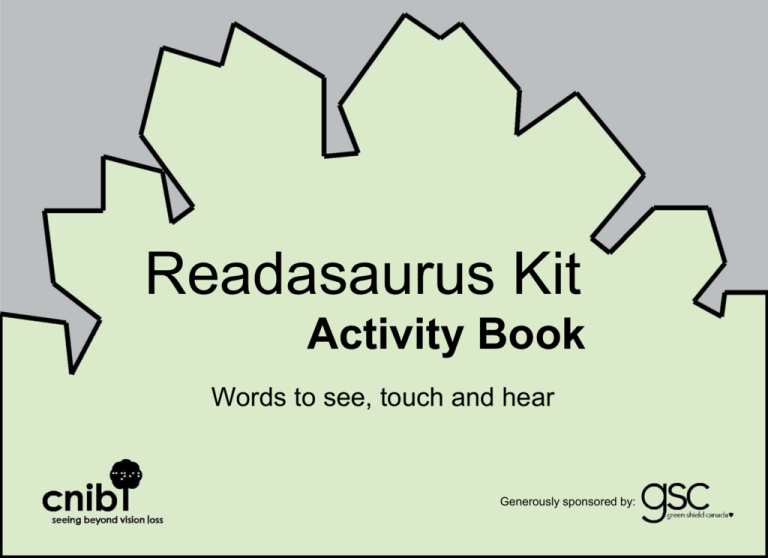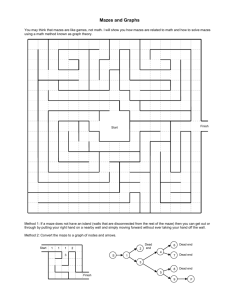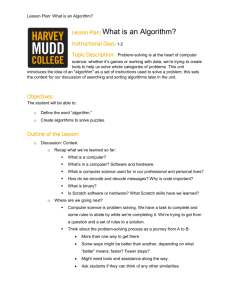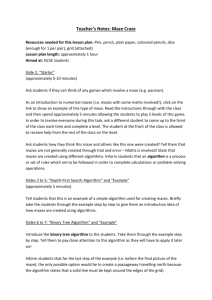Activity Book
advertisement

Readasaurus Kit Activity Book Words to see, touch and hear Generously sponsored by: Welcome to the Readasaurus Activity Book! This activity book belongs to your child. We recommend they use it with someone who already knows how to read: a parent, daycare worker, family member…even an older brother or sister! Explore this book in any order, depending on your child’s interests and abilities. What’s in the book? This book contains three sections of tactile pages. Each section starts with a Grown Ups! Tips page, with ideas for how you and your child can use the tactile pages to learn and have fun. • Numbers and letters • Shapes and colouring • Maze Later in the book you’ll find activity pages which outline games that you and your child can use to help them develop these important skills: • Listening (audio) • Touch and movement (tactile) • Comprehension (memory and understanding) Grown Ups! Tips: Letters and numbers • Cut the letter pages into squares so your child can put the letters in order, or use the squares to spell simple words. • On the number page, show your child how to follow the raised line from the number on the left to the triangle(s) on the right side of the number page. • Cut the number page into strips so your child can practice counting and begin to understand numbers. • • Make your own numbers or alphabet book by cutting and gluing the tactile/braille numbers and letters to pages in a binder. Beside each number or letter your child can add their own drawing or even glue or attach a real object (L is for leaf, 3 = 3 stickers, etc.). Let’s Wikki Stix can be used to make the shapes of different letters and numbers too! (Note: Wikki Stix are not for children under three years, and should not be used unsupervised.) get started! Grown Ups! Tips: Shapes and colouring • Use these pages to teach your child about different shapes. • Show your child examples of shapes in the real world. Plates are round and books are rectangular! • The house scene contains shapes too! Does your child know what a door is and how the doorknob works to open it? • Depending on their age and tactile skills, your child can explore the beach scene to: find the different shapes on the page find the girl on the page – and identify the different parts of the body compare a toy shovel and pail to the ones in the picture • Remember, this picture will make more sense to your child if they’ve played on the beach or in a sandbox. • Feeling especially crafty? Cut out a strip of sandpaper and glue it along the bottom of the page to represent the sand under the girl’s feet! • When your child has learned all they can from these pages, you can remove and display them on the refrigerator, or frame them to give as gifts to friends or family. Grown Ups! Tips: Maze • The maze included in this activity book may be too advanced for your child to begin with. Close your eyes and try it for yourself! • Don’t be discouraged! Understanding illustrations through touch is a skill that your child will need to learn and practice. • The activity page for “improving touch and movement skills” includes ideas for making mazes for your child. • Start with something simple: Teach your child to track (follow a line) across a page from left to right. Gradually increase the difficulty as your child becomes more confident. Improving listening skills Try these activities to help open your child’s ears to the world around them! Basic version: I hear Instead of playing “I spy with my little eye…” using things that you see, try playing “I hear with my little ear…” You can play it either in different rooms at home, or in public spaces like the mall, the library or the grocery store. • Make a list of all the different things you heard. • Help your child understand the source of familiar and unfamiliar noises (the hum of the refrigerator, the sound of someone typing on a keyboard, etc). • Every new sound is an opportunity for you to teach your child more about objects and experiences. • Remember, sighted kids can learn (passively) by watching, but children who are blind or partially sighted need hands-on (active) learning opportunities. As you play this game together, you’ll both get better at noticing and identifying different sounds! Advanced version: Sensory scavenger hunt Once your child has a good vocabulary of sounds and smells, you can put together a sensory scavenger hunt for them. A sensory scavenger hunt is a great quiet game. All you need to do is make a list of common smells and sounds; then challenge your child to check the items off as they notice them. I hear with my little ear something that… makes a whirring sound. I think it’s a lawn mower! Improving touch and movement skills Try these activities to help develop your child’s tactile sensitivity, mobility and special awareness skills. Basic version: Sensory play Encourage your child to explore different textures, like slime, pudding, bubbles, water, ice, foam, dirt, sand, dough, uncooked pasta, rice, oats and finger paint! It doesn’t have to be messy – take it outside, into the sink or bathtub, or put it in a plastic bin! Advanced version: Amazing mazes All kids benefit from learning to understand things through touch, and mazes are a great place to start practicing tactile tracking skills. Mazes can be small (to develop sensitivity in the fingers), but they can also be life-size (to learn and practice important orientation and mobility skills). Start out simple to give your child confidence and work your way to more advanced mazes later. Start with a short, straight line. Then make the line longer. Next try a wavy line. Be sure to have some kind of reward waiting at the end of the line for your child to find (like a cheerio or a goldfish cracker). • • If your child has low vision, use a thick, dark line on a plain, light background for best contrast. If your child will be doing the maze by touch, make sure the line is easy for them to find and feel. Materials to create mazes: • Lego • Cardboard, craft glue or glue pen (Draw a maze pattern on cardboard, then trace over the lines with a squeeze bottle of craft glue, or use 3D glue pens with sparkles and scents. Just be sure to let the glue dry completely!) • Cardboard, sandpaper, fabric (Glue strips of sandpaper or different textured fabric to cardboard to create the lines of the maze.) • Leaves (In the fall, you can rake leaves into maze patterns on the grass!) • Pebbles and sand (Place contrasting pebbles in maze patterns on the beach.) These mazes are amazing! Stumped for maze-making ideas? There are lots of tactile maze ideas online. Try searching Google images or Pinterest. Improving comprehension skills These activities can help your child learn to recognize differences and similarities between objects and sounds, and also build their memory skills. Basic version: Matching objects Teach your child to recognize similarities and differences through touch. For example, put two spoons and two forks on the table and ask your child which ones belong together. Advanced version: Memory/matching games “Memory” is a fully accessible, online matching game that uses keyboard controls to reveal hidden sounds. There are three different types of sounds: animal sounds, musical instrument sounds or weather sounds. Find this game (and more!) on altlit.ca, the CNIB Library’s website for kids and teens. You can play this game with real objects too: • Collect two clothespins, two pieces of Lego, two small plastic animals and two forks. • Lay them out (on the floor or on a table) in a rectangle or square, each a few inches apart. • Cover each object with a small square of fabric or cardboard that you’ve cut out (large enough to “hide” the individual objects). • Let your child uncover two objects at a time, trying to find objects that match. • If they don’t match, cover them up again. As they find matching pairs, they can leave them uncovered. Variations: • Increase the number of objects you hide. • Use objects that make sounds or have smells instead. • For more of a challenge, choose objects that have much smaller differences (for example, two plastic forks, two dessert forks, two regular forks, two forks with patterned handles, etc.). I hope I remember to play this memory game again! Visit our website for kids, teens, parents and teachers at altlit.ca Connect with us! @cniblibrary /cniblibrary /cniblibrary Colouring sheets within this kit were produced for CNIB by: Tactile Vision Graphics 27 Monk Street, Ottawa, ON K1S 3Y7 tactilevisiongraphics.com Some images are copyrighted by Tactile Vision Graphics and have been used with permission. Charitable registration #: 119219459 RR0003 /cniblibrary Generously sponsored by:






